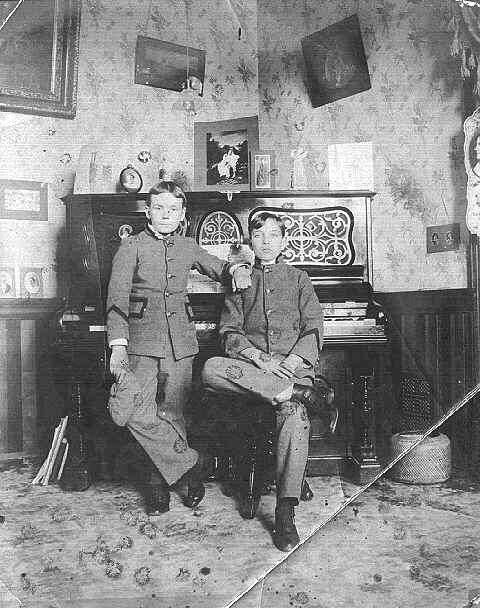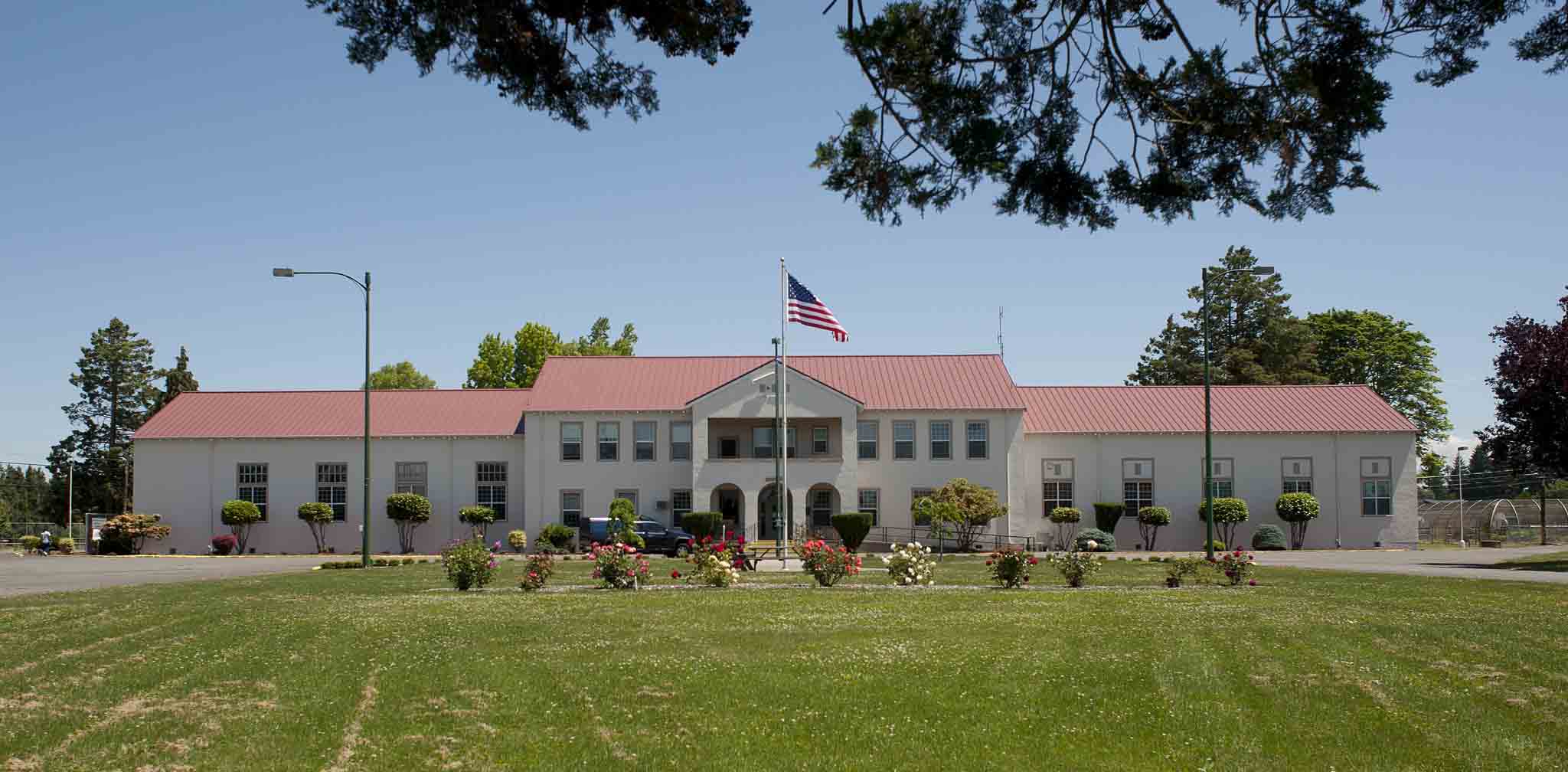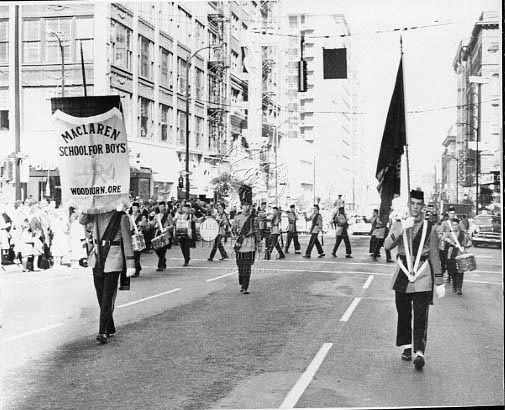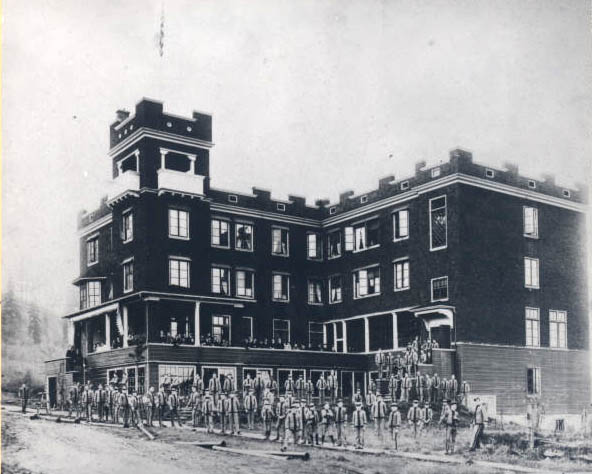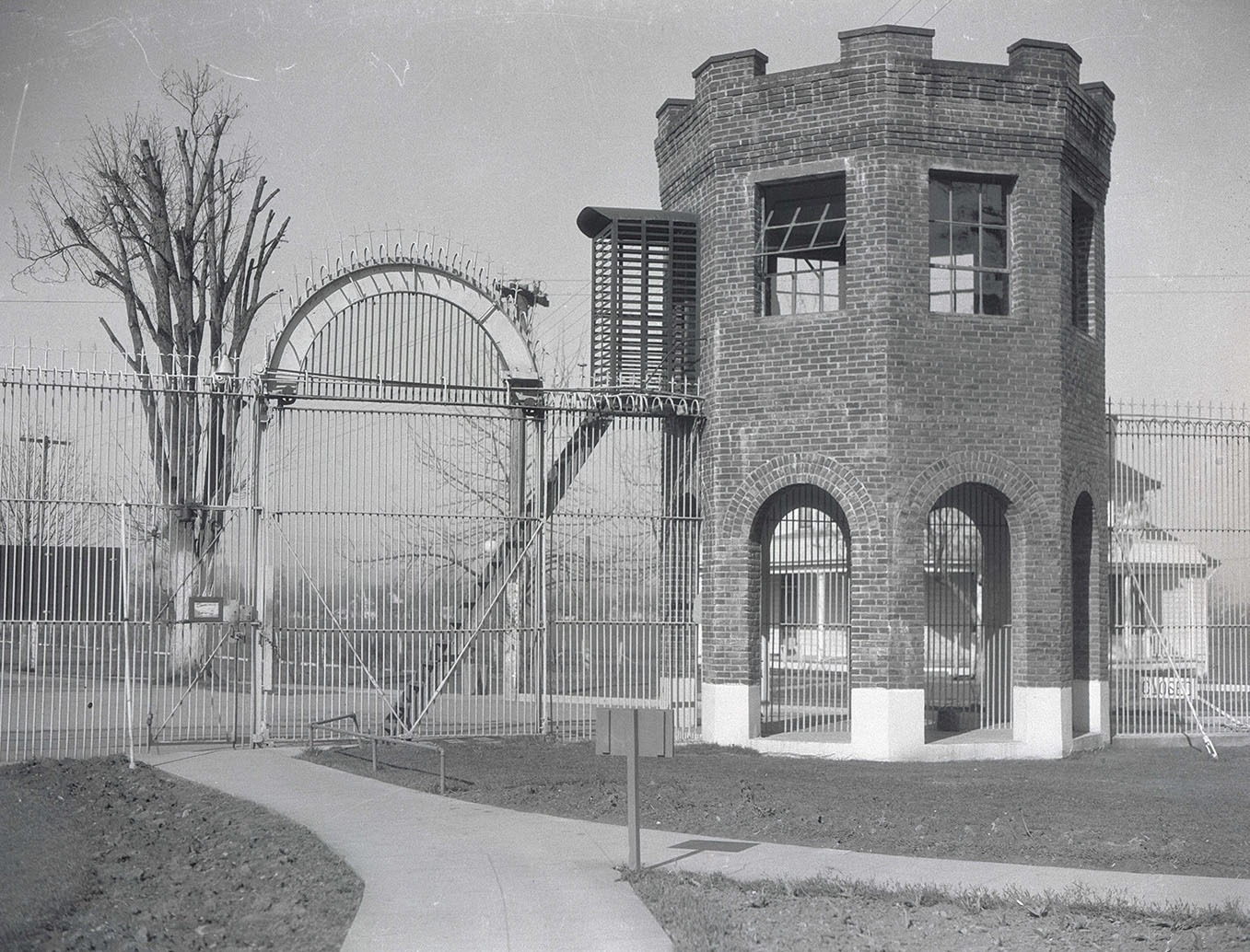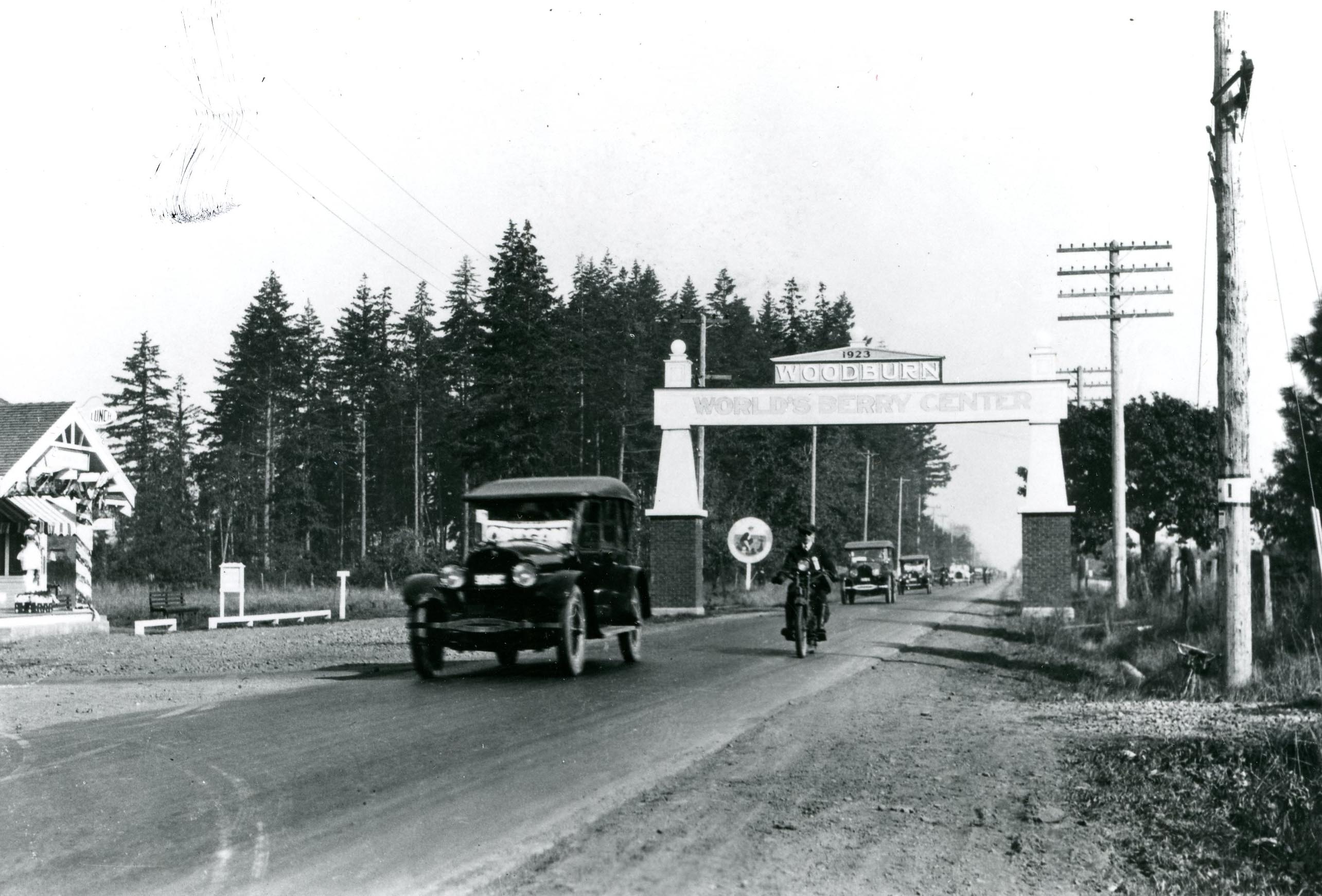The MacLaren Youth Correctional Facility in Woodburn is one of five correctional facilities overseen by the Oregon Youth Authority. Established in 1926 as the Woodburn School for Boys, MacLaren was built to alleviate overcrowding at the state’s first correctional institution for boys, the Oregon State Reform School in Salem. The school serves up to 271 youth (ages twelve to twenty-four) for an average stay of nine months. The facility offers treatment programs, education and vocational training, and medical services.
Opened in 1891, Oregon’s first reform school was a product of the Progressive Era, when reform schools and local juvenile justice systems were commonly viewed as a means of care and rehabilitation for children who had a real or perceived lack of parental guidance or who would otherwise be tried in court and incarcerated as adults. While most boys were placed in the State Reform School because of criminal infractions, ranging from incorrigibility (repeatedly disobeying his parents) to acts of violence, others were in state custody simply because their families could not care for them.
When the Reform School was closed in 1929 after a fire destroyed the main building, the Woodburn School for Boys, which had opened in 1926, became the only such school for boys in the state. The school’s design sought to provide a normative environment for boys who were committed for rehabilitation and vocational training. Several residential buildings were staffed with house parents, and the boys were placed in groups based on age or behavior. Although two small rooms were set aside in each residential cottage for disciplinary segregation, the goal was to provide a supervised, homelike environment that avoided the visual markers of incarceration, such as a perimeter fence.
Cottages at the Woodburn School were arranged around a formal quadrangle, part of a design by Arthur L. Peck, professor of landscape architecture at Oregon Agricultural College (today’s Oregon State University). Most of the buildings were designed by Knighton & Howell Architects & Engineers, and boys at the school constructed agricultural buildings as part of a robust food-growing and vocational education program.
The late 1940s marked the beginning of a transition at the school as the emphasis on rehabilitation and vocational training shifted toward security and confinement. The changes aligned with a 1946 study of the Woodburn School and the Hillcrest School in Salem, the state’s reform school for girls, by the National Probation Association. The Woodburn School had overcrowded and understaffed cottages, the study found, and lacked adequate overnight supervision. A summary report noted an inconsistency in the committing policies of Oregon courts, which led to imposing the same treatment program—removing boys from their community and committing them to training school—for truancy and violent crimes alike.
The National Probation Association recommended that a separate unit be built at Woodburn for intake, health services, and the isolation and detention of boys. A segregation unit was constructed in 1948.
In 1951, the Woodburn School was renamed the MacLaren School for Boys, for William G. MacLaren, a Portland Free Methodist minister known for his charity work with the Pacific Coast Rescue and Protective Society. Agricultural vocational training was maintained at the school through the 1950s and early 1960s, but it was phased out in favor of other vocational training and classroom learning. The school’s population grew steadily during this period, and overcrowding became an issue in the 1970s, which some attributed to the broad commitment policies of Oregon courts. To reduce the reliance of local communities on state reform schools for treatment, there was an attempt to merge the operations of the MacLaren and the Hillcrest schools; but the merger backfired, and the overcrowding worsened. Complaints ranged from a lack of due process in disciplinary action to extended solitary confinement without adequate access to restrooms and clothing.
A class action lawsuit filed in 1977 alleged that the constitutional rights of boys at MacLaren had been violated. The lawsuit, which was settled out of court, and a 1985 U.S. District Court ruling led to several changes at MacLaren, including a lower student-to-staff ratio, a ban on using cells except in extreme cases, hiring trained counselors for a new crisis unit, and a decreased time limit for solitary confinement. Since then, annual performance reviews, audits, and progress reports have been made available to the public and have been used to measure progress in the safety and treatment of youth at the facility.
The Oregon Youth Authority, the state’s juvenile corrections agency, was formed in 1995 as part of an effort to separate juvenile corrections from child welfare. It became an independent department in 1996, and it was during this period that the school was renamed the MacLaren Youth Correctional Facility. OYA has since implemented a positive development ethos at MacLaren to ease the reintegration of boys into their communities, and programs such as STEPS (stop, think, explore, plan) have been implemented to defuse tension and provide youth with counselors instead of imposing punishment and isolation.
-
![]()
Boys at MacLaren.
Courtesy Oregon State Archives, Salem Public Library -
![]()
MacLaren Youth Correctional Facility.
Courtesy State of Oregon -
![]()
MacLaren grounds, c.1913.
Courtesy Oregon State Archives, Salem Public Library -
![]()
MacLaren dining room, c.1910.
Courtesy Oregon State Archives, Salem Public Library -
![]()
MacLaren Drum & Bugle Corp, 1961.
Oregon Historical Society Research Library, 018056
Related Entries
-
![Hill Military Academy]()
Hill Military Academy
Hill Military Academy was a prominent military school in Portland, Oreg…
-
![Oregon State Penitentiary]()
Oregon State Penitentiary
The Oregon State Penitentiary, Oregon's only maximum-security prison, s…
-
![Woodburn]()
Woodburn
Woodburn has always had a dynamic identity. Located in French Prairie i…
Related Historical Records
Map This on the Oregon History WayFinder
The Oregon History Wayfinder is an interactive map that identifies significant places, people, and events in Oregon history.
Further Reading
Blaser, Andrea. Results of Historic Resources Documentation at the Hillcrest Youth Correctional Facility, Salem, Marion County, Oregon. Archaeological Investigations Northwest, Inc. Report No. 3950. Prepared for Oregon Department of Administrative Services, Salem, Oregon, 2017.
Charlton, T. J. "Juvenile Reformatories of the United States." In The Reformatory System in the United States: Reports Prepared for the International Prison Commission, pp. 223-228. Washington, D.C.: Government Printing Office, 1900.
Marsh, F.H. "State Reform School." Portland Morning Oregonian, December 3, 1875.
"The Reform School: Workings of That Institution." Portland Morning Oregonian, August 20, 1892.
Gardner, W.T. "Juvenile Courts and What They Have Accomplished." Portland Sunday Oregonian, May 8, 1904.
Gilbert, L.M. "New Buildings of Boys State Training School North of Woodburn." Statesman Journal, January 1, 1926.
Weiser, John H. "Great experiment saves Oregon lads." Portland Sunday Oregonian, May 4, 1930.
Hobart, Sue. "MacLaren School goes coed with arrival of Hillcrest girls." Portland Oregonian, September 8, 1973.
Olmos, Robert. "Chaos’ builds at juvenile schools." Portland Sunday Oregonian, June 2, 1974.
"MacLaren Boys Ill Treated, Suit Alleges." Portland Oregonian, January 27, 1978.



